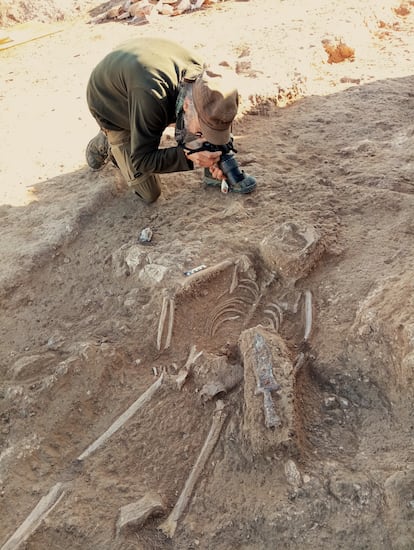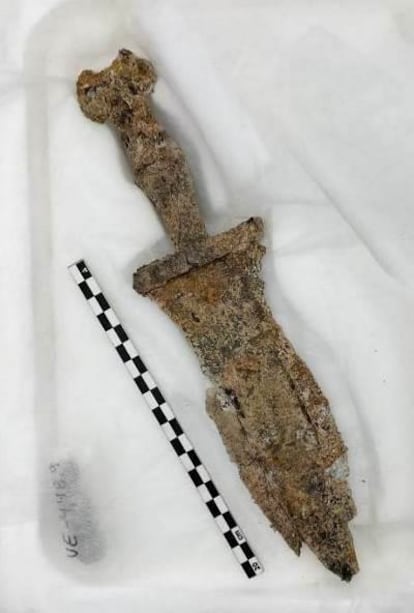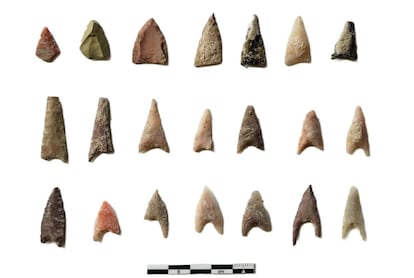Uncovered in Spain: 5,000-year-old fortress with a violent past
The structure consists of three concentric walls up to five meters high and 25 towers. Inside, the tomb of a possible Roman legionary has been discovered

Some 4,900 years ago, during the Copper Age, a group of humans constructed a formidable fortress on a hill in what is now the Spanish city of Almendralejo in Badajoz province. This stronghold was protected by three concentric walls, 25 bastions or semicircular towers, and three deep ditches measuring up to four meters wide and two meters deep. Spanning 13,000 square meters, the complex featured robust stone and adobe walls, with a single entrance just 70 centimeters wide — designed to make it virtually impregnable.
Yet, despite its formidable defenses, the fortress was ultimately destroyed, burned, and razed by enemies, then abandoned 400 years after its construction.
The archaeological research team at Tera S.L. uncovered this site in 2021 and continues to excavate it. Its characteristics closely resemble those of Los Millares in Almería province, the reference model for Chalcolithic settlements in the southeast of the Iberian Peninsula.
Who attacked and destroyed this fortification, how they did it, and what exactly it was built to protect remain unanswered questions. “But we are getting closer,” says César M. Pérez, director of the excavations.
In addition to the structure itself, archaeologists have uncovered numerous artifacts within the site, including arrowheads, idols, axes, grinding stones, plates, bowls, and loom components. These findings, along with other materials, provide valuable insight into the activities that once took place inside the fortification.
According to the archaeological research team, the pentagonal fortress — the first to be built atop a hill 314 meters above sea level — offered a commanding view of the surrounding landscape. Its original structure featured an adobe wall between 1.3 and 1.5 meters thick, five bastions, and a single entrance described as being “shaped like crab claws.”
Later, two additional concentric walls were constructed around it, reinforced by three defensive ditches. In short, it was “a formidable defense, as the 25 bastions were strategically designed to maximize firing angles and provide protection from multiple points.” The three ditches “not only served as physical barriers but also had a psychological impact, discouraging attackers and forcing potential invaders to overcome additional obstacles before reaching the walls,” explains Pérez.
The defensive complex was discovered during preliminary surveys for a photovoltaic solar park planned by the Spanish energy company Acciona Energía on the estate of the Marquis of the Encomienda. In the area of the old Cortijo Lobato — after which the archaeological site is named — researchers identified Chalcolithic-era materials concentrated in an olive grove. This discovery alerted the archaeological team, prompting the implementation of protocols for site protection, archaeological investigation, and impact prevention, all financed by the energy company.

The fortification of Cortijo Lobato included cabins and a water reservoir to sustain the population during times of siege. “The complex system of walls and ditches, built from both stone and earth, demonstrates careful planning that required the coordination of a large group of people. This level of organization suggests the existence of some form of hierarchy or leadership capable of overseeing a project of this scale. The sophistication of the defensive design and the need for a significant workforce reinforce the idea of a structured and well-organized community,” explains César Pérez.
Archaeologists have found evidence that Cortijo Lobato suffered “a widespread fire that affected key areas of the settlement. One of the strongest indications that this was an intentional act is the burning of wooden doors embedded in the adobe walls. These doors were far from other flammable materials, which suggests that the fire was not accidental, but rather the result of an assault on the fortification — a scene of violence and destruction in which the settlement was attacked, its defenses breached, and the structure ultimately set ablaze.” Among the remains, researchers uncovered numerous arrowheads.

Cortijo Lobato was ultimately abandoned around 2450 BC, according to carbon-14 dating of animal remains found among the ashes of the fire. The next trace of human presence does not appear until the Late Roman Empire (2nd–3rd centuries AD), after a silence of 2,700 years. From this later period, archaeologists uncovered an unusual grave near the second defensive ditch.
The solitary, shallow burial contained the remains of a man between 25 and 35 years old, laid face down with a pugio (dagger) on his back. “This suggests the individual may have had a military role, as the pugio was the standard dagger used by Roman legionaries.” The burial appears to have been carried out in haste, as “the pit was barely deep enough to contain the body.” The skeleton was almost complete except for the feet, which seem to have been cut off. Remarkably, the dagger was found in an exceptional state of preservation — fully intact and still in its sheath.
The Roman pugio dates back to the late 1st century BC and was inspired by earlier daggers used in pre-Roman Hispania. The Celtiberians had wielded similar weapons since the late 4th century BC, while the Autrigones, Vettones, Vacceos, and Berones favored a curved-edged dagger from the late 3rd century BC.
Roman legionaries first encountered these weapons during the fierce battles they fought against these peoples throughout the 2nd century BC, where they became prized war trophies. Over time, the pugio was modified and eventually adopted as standard equipment for legionaries across the empire.

At first, archaeologists debated whether the skeletal remains belonged to a soldier or a civilian who had simply acquired the dagger. However, the deliberate placement of the pugio in the burial “is a way of indicating he was a member of the army and was given a dishonorable burial,” a rare practice for this period, hinting at a story yet to be uncovered.
If confirmed to be a soldier, “he could only have belonged to Legio VII Gemina,” the only Roman legion stationed in Hispania at the time. Established in 74 AD, this legion was quartered in Legio (modern-day León) in the territory of the Asturians. Unlike other legions engaged in direct military campaigns, Legio VII Gemina primarily carried out escort duties, road surveillance, and provincial security.
The recovered pugio has since undergone laboratory treatment under the guidance of restoration specialist Maicu Ortega, from Madrid Complutense University, “for its analysis, consolidation and partial stabilization to guarantee its preservation and prevent deterioration.” Additionally, researchers are attempting to extract DNA from one of the individual’s teeth.
The cause of death, the unusual face-down burial with severed feet, and the placement of the pugio on the individual’s back remain, as the archaeologists describe it, “a real mystery.”
Sign up for our weekly newsletter to get more English-language news coverage from EL PAÍS USA Edition
Tu suscripción se está usando en otro dispositivo
¿Quieres añadir otro usuario a tu suscripción?
Si continúas leyendo en este dispositivo, no se podrá leer en el otro.
FlechaTu suscripción se está usando en otro dispositivo y solo puedes acceder a EL PAÍS desde un dispositivo a la vez.
Si quieres compartir tu cuenta, cambia tu suscripción a la modalidad Premium, así podrás añadir otro usuario. Cada uno accederá con su propia cuenta de email, lo que os permitirá personalizar vuestra experiencia en EL PAÍS.
¿Tienes una suscripción de empresa? Accede aquí para contratar más cuentas.
En el caso de no saber quién está usando tu cuenta, te recomendamos cambiar tu contraseña aquí.
Si decides continuar compartiendo tu cuenta, este mensaje se mostrará en tu dispositivo y en el de la otra persona que está usando tu cuenta de forma indefinida, afectando a tu experiencia de lectura. Puedes consultar aquí los términos y condiciones de la suscripción digital.
More information
Archived In
Últimas noticias
‘How does it feel to be a failure?’: Elizabeth Berkley’s journey from ‘Showgirls’ ridicule to vindication
The story of the Málaga virus: The code that haunted Google’s cybersecurity center director for 30 years
The impact of Ecuador’s mega-prison: A polluted river, cleared forests and military checkpoints
Corinne Low: ‘I’m more concerned about the female happiness gap than the gender wage gap’
Most viewed
- The low-cost creative revolution: How technology is making art accessible to everyone
- Christian Louboutin: ‘Young people don’t want to be like their parents. And if their parents wear sneakers, they’re going to look for something else’
- All the effects of gentrification in one corner of Mexico’s Colonia Roma
- Liset Menéndez de la Prida, neuroscientist: ‘It’s not normal to constantly seek pleasure; it’s important to be bored, to be calm’
- Christmas loses its festive spirit: ICE fears cast shadow over religious celebrations










































